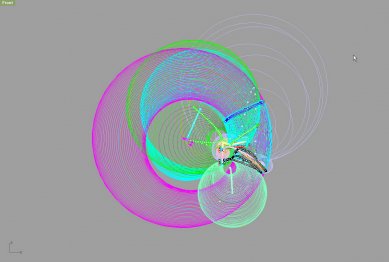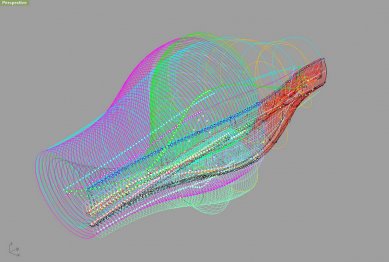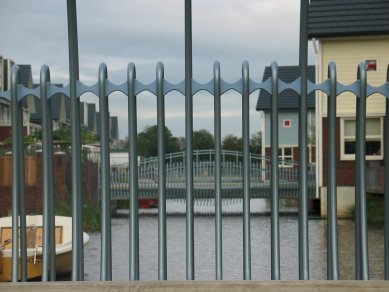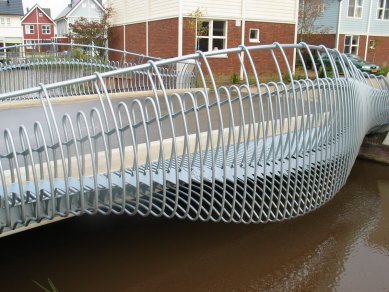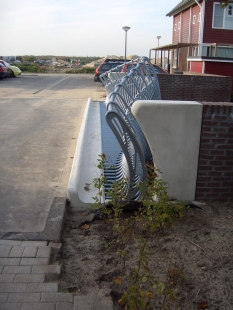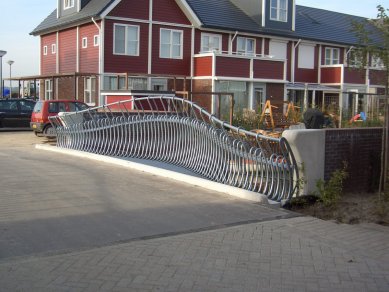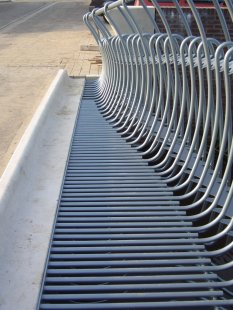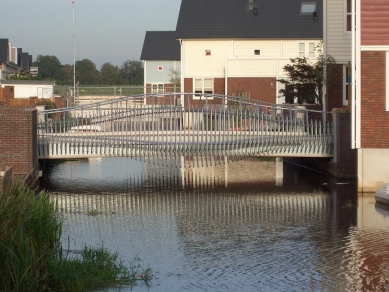
The Aquarians
22 bridges in the Watertuinen

Author team: Joan Almekinders, Radek Brunecký, Maurice Nio, Alexander Paschaloudis
It could be easily said that despite the DELTA Works [1], the strength and power of water in the Netherlands has only increased. It has merely changed and adapted its tactics. Instead of brute force, it uses all its charm and slowly seeks its way into areas far from the polders, into the highest and driest places in the country. Following the slogan "living on water" (wonen aan het water), it flows with the greatest pleasure and elegance into new residential areas and seems unstoppable. This is also the case in Den Bosch, where water channels were built in a new residential area before the roads.
Therefore, it can hardly be surprising that the beauty and allure of the water element has captivated even 22 bridges in Den Bosch. Structures like bridges and tunnels always bravely withstand the effects of gravity and water pressure. What can you do, water has even reached Brabant [2]. This time, it was not met with courageous bravery, but was outsmarted by charming collaboration. If we cannot defeat it...
Just like Bambi seeing its reflection for the first time in the surface of the lake, these bridges shine with delight, overwhelmed by their ability to mimic a drop of water.
These 22 drops, which we placed like pearls across the map of Watertuinen (Water Gardens), have completely soaked the steel and concrete of the bridges. Seemingly hard and rigid materials bend and change shape into the form of a tear under the torturous pressure of surface tension. The bridge is widest in the middle, where the steel structure is highest and the shape fullest. This is the place where the bridge ceases to be a bridge. The point where even passing cars begin to envy the water.
[1] one of the largest flood protection projects in the world, involving 10,250 miles of flood defenses and over 300 engineering structures. The implementation began in 1953 after catastrophic floods that claimed 1,835 lives, forced 70,000 to evacuate, drowned 10,000 animals, and destroyed 4,500 homes; (author's note)
[2] a province in southern Holland; (author's note)
The author's report speaks of drops that soak concrete and steel... In reality, this was indeed the case. A simple 3D computer model of the bridge was assigned the physical properties of liquids, and the bridge's reaction was tested after interacting with a falling drop of water. The results inspired the final design. The task itself brought smiles to faces from the beginning. In the drawing photographs, you would find it in vain to look for water. The task was to design 22 bridges over water channels that were yet to be artificially dug. Today they are dug and divide the "satellite town" on the outskirts of Den Bosch into four islands.
The production process itself was not simple at all and not inexpensive either. Although each bridge was drawn down to the last 2D detail, in the end, the absolutely precise 3D model was crucial. To check all the pitfalls, a test segment of the bridge was made to a 1:1 scale. All eight types of the 22 bridges were modeled in 3D multiple times and subsequently changed countless times to meet all limits. Especially the limits of the bending machine, which at first glance seemed limitless (it can bend all types of profiles according to double-curved -definitional curves with double curvature). The steel is surface-treated with a special coating technology that contains two pigments. As a result, the bridge partially changes color depending on the angle of incidence of light.
Bringing the entire project to realization took a lot of sweat, but the feeling of balancing on the edge of technological possibilities that accompanied the entire project was wonderfully exciting.
It could be easily said that despite the DELTA Works [1], the strength and power of water in the Netherlands has only increased. It has merely changed and adapted its tactics. Instead of brute force, it uses all its charm and slowly seeks its way into areas far from the polders, into the highest and driest places in the country. Following the slogan "living on water" (wonen aan het water), it flows with the greatest pleasure and elegance into new residential areas and seems unstoppable. This is also the case in Den Bosch, where water channels were built in a new residential area before the roads.
Therefore, it can hardly be surprising that the beauty and allure of the water element has captivated even 22 bridges in Den Bosch. Structures like bridges and tunnels always bravely withstand the effects of gravity and water pressure. What can you do, water has even reached Brabant [2]. This time, it was not met with courageous bravery, but was outsmarted by charming collaboration. If we cannot defeat it...
Just like Bambi seeing its reflection for the first time in the surface of the lake, these bridges shine with delight, overwhelmed by their ability to mimic a drop of water.
These 22 drops, which we placed like pearls across the map of Watertuinen (Water Gardens), have completely soaked the steel and concrete of the bridges. Seemingly hard and rigid materials bend and change shape into the form of a tear under the torturous pressure of surface tension. The bridge is widest in the middle, where the steel structure is highest and the shape fullest. This is the place where the bridge ceases to be a bridge. The point where even passing cars begin to envy the water.
author's report
[1] one of the largest flood protection projects in the world, involving 10,250 miles of flood defenses and over 300 engineering structures. The implementation began in 1953 after catastrophic floods that claimed 1,835 lives, forced 70,000 to evacuate, drowned 10,000 animals, and destroyed 4,500 homes; (author's note)
[2] a province in southern Holland; (author's note)
The author's report speaks of drops that soak concrete and steel... In reality, this was indeed the case. A simple 3D computer model of the bridge was assigned the physical properties of liquids, and the bridge's reaction was tested after interacting with a falling drop of water. The results inspired the final design. The task itself brought smiles to faces from the beginning. In the drawing photographs, you would find it in vain to look for water. The task was to design 22 bridges over water channels that were yet to be artificially dug. Today they are dug and divide the "satellite town" on the outskirts of Den Bosch into four islands.
The production process itself was not simple at all and not inexpensive either. Although each bridge was drawn down to the last 2D detail, in the end, the absolutely precise 3D model was crucial. To check all the pitfalls, a test segment of the bridge was made to a 1:1 scale. All eight types of the 22 bridges were modeled in 3D multiple times and subsequently changed countless times to meet all limits. Especially the limits of the bending machine, which at first glance seemed limitless (it can bend all types of profiles according to double-curved -definitional curves with double curvature). The steel is surface-treated with a special coating technology that contains two pigments. As a result, the bridge partially changes color depending on the angle of incidence of light.
Bringing the entire project to realization took a lot of sweat, but the feeling of balancing on the edge of technological possibilities that accompanied the entire project was wonderfully exciting.
Radek Brunecký
The English translation is powered by AI tool. Switch to Czech to view the original text source.
0 comments
add comment


